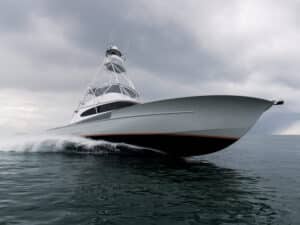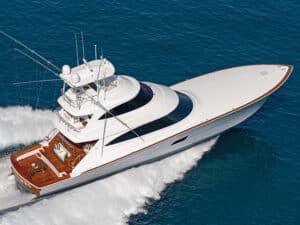John Bayliss has been in the boat business his entire life – first as crew, then as captain, then as factory captain for Hatteras Yachts and now as proprietor of Bayliss Boatworks. His boats unfailingly win raves for their speed, beauty and quality of construction, elevating his company to “one-of-the-best-in-the-world” level. But as quality improves, further gains become more difficult. Amazingly, the new Bayliss 65’s attention to detail ratchets the quality up yet another few notches.
Performance
The Bayliss 65 sports a pair of Caterpillar C32s rated at 1,650 hp each. Though Bayliss will install whatever an owner wants for power, he feels this selection fits all the boat’s parameters exceptionally well. ZF electronic controls make adjusting throttles and shifting silky smooth and provide almost infinite adjustability on trolling valves. At slow idle (550 rpm), we transited Charleston Harbor at about 6.5 knots. At 10 knots, a fair bit of surface turbulence filled the wake for about three waves back, but very little subsurface white water appeared outside the prop wash.
Seas outside the breakwaters at Charleston Harbor couldn’t challenge the Bayliss 65. Finding the biggest ship wake I could showed me that the Bayliss 65 didn’t care about it head-on, and down-sea the boat lowered its bow off the wave gently, blowing the spray out and down. Never once did we get a single drop on the enclosure all day.
With no tabs, the 65 took 11 seconds to develop boost and plane with a set of five-bladed props. Four blades would probably offer greater torque and shorter time to plane, but not as smooth a ride. Turn the power-assisted steering hard over at 35 knots and the Bayliss carves a 180-degree course change in about six boat lengths. Four-blade props would probably improve the turning radius as well.
Backing down-sea at 7 knots caused water neither to come over the transom nor come up through the scuppers. Barely a trickle came in around the tuna door.
This hull represents the first Bayliss built with prop tunnels. These 7-inch-deep cavities really improve handling and fuel efficiency.
Flybridge
Bayliss raised the nonskid portion of flooring on the flybridge and elsewhere throughout the boat (heads, showers, etc.). Nonskid affords excellent traction for walking and makes cleaning much easier beause the dirt and grime run off into the slick Awlgripped troughs around the perimeter of the space.
Another innovative feature consists of stainless-steel refrigerated drink boxes and a deep freeze on the forward side of the console with a straight settee in front of them. In fact, all reefer and freezer spaces aboard are stainless steel.
Engine Room
Over six feet of headroom in the engine compartment makes maintenance chores much easier on the back. Bayliss also provides plenty of room to pass between the engines without getting your sleeves dirty on the Walker Airseps. You’ll find very simple engine maintenance points all on centerline. A transverse bulkhead at the forward end forms a pump room that holds the watermakers, pumps, compressors, a stainless workbench with a stainless vise, custom-painted toolboxes, storage drawers and so on. Even I could walk unimpeded to the outboard side of the engines where the batteries (among other things) are located.
Bayliss includes a fuel filter between the fore and aft fuel tanks. If the forward tank stays empty for a while, any condensation that forms when you fill it won’t flush back into the aft tank. Quick-disconnect hose fittings on the engines allow you to transfer fuel, prime cylinders, change oil and perform a host of other functions. So not only are all the routine engine-maintenance points easy to reach on centerline, virtually all of your emergency functions are there, too.
Interior
You’ll be hard-pressed to find a straight line or a right angle on the Bayliss. While some people might consider the interior of this Bayliss stark or cold, I prefer to think of it as clean.
Rounded door tops prevent head butts when entering and exiting. Bayliss now builds all doors out of aluminum honeycomb with a 1208 fiberglass skin and 4 mm Okume marine plywood covered with a teak veneer.
In the salon, a big-screen LCD-TV rises on hidden rams from the starboard side counter – part of an extensive entertainment system that includes a wireless computer printer.
The portside guest cabin sports triple single berths, while the crew’s quarters to starboard offer twin singles. The master stateroom sports a queen berth; however, since this is a custom boat, you can design the accommodations to suit your specific needs.
Cockpit
John Bayliss has two mantras: Functionality and flexibility. For example, the transom livewell’s ingenious design incorporates removable tuna tubes that store in the lazarette when not in use. When needed, they fit right into the livewell and hook up to existing plumbing.
A misting system augments the forced-air cooling along the cockpit mezzanine. The mezzanine also includes two insulated dry boxes, another stainless-steel freezer, a small storage compartment for chamois and wiper blades, an insulated drink box and the cascading twin receiver/storage boxes for the Eskimo icemaker that’s capable of pumping out 600 pounds of crushed ice daily.
More attention to detail: The teak cap rail as well as the in-deck toe pieces are all carved out of a single log to avoid seams. All existing seams match. Teak planks in the cockpit line up with other seams throughout. Locker openings match up with internal panels. How does Bayliss accomplish this? All seams are pulled off the centerline.
Design and Construction
As I mentioned, one of Bayliss’s greatest talents comes in his use of dead space. You’ll find precious little of it aboard this or any of his boats. But with each succeeding hull, he displays greater creativity in that vein. The owner of this 65 wants to carry a dinghy to get back and forth from his anchorage. To power the outboard, Bayliss installed a separate 20-gallon gas tank. The pump for the gas hose works off a remote air compressor for safety.
You’ll find pop-up bow cleats and a clean-looking deck without rails. But thankfully, Bayliss fully understands the danger of working a foredeck without nonskid. This one has it in spades.
Visit Bayliss at www.baylissboatworks.com_._







